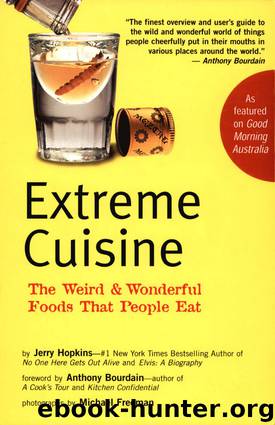Extreme Cuisine by Jerry Hopkins

Author:Jerry Hopkins
Language: eng
Format: epub
ISBN: 0-7946-0255-X
Publisher: Tuttle Publishing
Ostrich & Emu
Some years ago, while staying with a family in Capetown, South Africa, I found myself alone in the kitchen, foraging for something to eat. I opened the refrigerator door and saw, for the first time, an ostrich egg. It was about the size of an American football, somewhat fatter in the middle and rounded at the ends, and it occupied nearly half an entire refrigerator shelf. Before the day was out, it became the centerpiece for a meal, an omelet for ten, equal to about twenty chicken eggs. I was impressed. (As much by the rather bland taste as the necessity of using a heavy wooden mallet to open it.) In the 1970s, the ostrich was not commonly regarded as a protein source, at least not outside its usual habitats, mainly in Australia and South Africa. Times have changed.
I'm drawn to ostriches. Like many people, I'm attracted to the physical oddities in the animal world. Giraffes, duckbilled platypuses, elephants, that sort of thing. Animals that look like they've been made out of spare parts for several species, or are too large to be practical or believable. They appear to be Mother Nature's private jokes, like dinosaurs and bats. Ostriches, with their long, skinny necks and legs, their bulky bodies covered with feathers, and such big adorable eyes, must be liked as well as gaped at. Is it not for this reason that Big Bird is such a favorite character on television's Sesame Street?
That said, the ostrich's image in much of the world is that of a long-legged, long-necked, cowardly creature that sticks its head in the sand to avoid confrontation. This impression may be based on when the bird is resting, it sits on its haunches and extends its neck so it can look out for danger. This means all anyone sees from a distance is the ample bulk of its body with a head held close to the earth. In fact, the ostrich is not cowardly and can be quite aggressive, and when a bird up to eight or nine feet in height weighing as much as 300 pounds, with a ground speed of up to forty miles an hour in short sprints, takes a disliking to some intruder into ostrich territory, that someone or something is best advised to escape by any means available, preferably by horse or car. The Guinness Book of Records calls it the world's largest and fastest bird. Its egg is also the largest.
The ostrich, or Struthio camelus, originated in the Asiatic steppes during the Eocene Epoch, forty to fifty million years ago, and once ranged through much of Asia, Europe, and Africa. Ancient Egyptians trained them to pull carts and over 2,000 years ago, the Egyptian queen Arsinoe rode an ostrich with a saddle. Teams of ostriches sometimes were used in Rome to pull chariots.
The ostrich's history as a food is long, going back to the days of Roman empire, when strange foods—even for the time—seemed to be almost mandatory cuisine for emperors.
Download
This site does not store any files on its server. We only index and link to content provided by other sites. Please contact the content providers to delete copyright contents if any and email us, we'll remove relevant links or contents immediately.
Annapurna by Maurice Herzog(3305)
Liar's Poker by Michael Lewis(3233)
A Forest Journey by John Perlin(2925)
Atlas Obscura by Joshua Foer(2708)
The Ogre by Doug Scott(2510)
Cuba by Lonely Planet(2491)
Photographic Guide to the Birds of Indonesia by Strange Morten;(2413)
Tokyo by Rob Goss(2295)
All Things Reconsidered by Bill Thompson III(2268)
The Splendid and the Vile by Erik Larson(2235)
A TIME OF GIFTS by Patrick Leigh Fermor(2107)
INTO THE WILD by Jon Krakauer(2089)
Fatal Storm by Rob Mundle(2086)
Trail Magic by Trevelyan Quest Edwards & Hazel Edwards(2065)
DK Eyewitness Top 10 Travel Guides Orlando by DK(2060)
Abbey in America by Murray John A(2018)
Top 10 Dubai and Abu Dhabi by DK Travel(1995)
Touching the Void by Joe Simpson(1976)
Lonely Planet Australia by Lonely Planet(1974)
